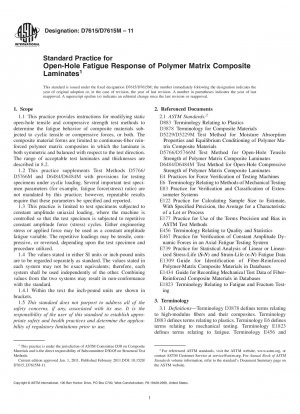ASTM D7615/D7615M-11
Standard Practice for Open-Hole Fatigue Response of Polymer Matrix Composite Laminates
- Standard No.
- ASTM D7615/D7615M-11
- Release Date
- 2011
- Published By
- American Society for Testing and Materials (ASTM)
- Status
- Replace By
- ASTM D7615/D7615M-11(2018)
- Latest
- ASTM D7615/D7615M-23
- Scope
This practice provides supplemental instructions for using Test Methods D5766/D5766M or D6484/D6484M to obtain open-hole fatigue data for material specifications, research and development, material design allowables, and quality assurance. The primary property that results is the fatigue life of the test specimen under a specific loading and environmental condition. Replicate tests may be used to obtain a distribution of fatigue life for specific material types, laminate stacking sequences, environments, and loading conditions. Guidance in statistical analysis of fatigue data, such as determination of linearized stress life (S-N) curves, can be found in Practice E739.
This practice can be utilized in the study of fatigue damage in a polymer matrix composite open-hole specimen such as the occurrence of microscopic cracks, fiber fractures, or delaminations. The change in strength associated with fatigue damage may be determined by discontinuing cyclic loading to obtain the static strength using Test Methods D5766/D5766M or D6484/D6484M.
Note 28212;This practice may be used as a guide to conduct variable amplitude loading. This information can be useful in the understanding of fatigue behavior of composite structures under spectrum loading conditions, but is not covered in this standard.
Factors that influence open-hole fatigue response and shall therefore be reported include the following: material, methods of material fabrication, accuracy of lay-up, laminate stacking sequence and overall thickness, specimen geometry, specimen preparation (especially of the hole), specimen conditioning, environment of testing, type of support fixture, specimen alignment and gripping, test frequency, force (stress) ratio, normal stress magnitude, void content, and volume percent reinforcement. Properties that result include the following:
Specimen stiffness versus fatigue life curves for selected normal stress values.
Normal stress versus specimen stiffness curves at selected cyclic intervals.
Normal stress versus fatigue life curves for selected stress ratio values.
1.1 This practice provides instructions for modifying static open-hole tensile and compressive strength test methods to determine the fatigue behavior of composite materials subjected to cyclic tensile or compressive forces, or both. The composite material forms are limited to continuous-fiber reinforced polymer matrix composites in which the laminate is both symmetric and balanced with respect to the test direction. The range of acceptable test laminates and thicknesses are described in 8.2.
1.2 This practice supplements Test Methods D5766/D5766M and D6484/D6484M with provisions for testing specimens under cyclic loading. Several important test specimen parameters (for example, fatigue force(stress) ratio) are not mandated by this practice; however, repeatable results require that these parameters be specified and reported.
1.3 This practice is limited to test specimens subjected to constant amplitude uniaxial loading, where the machine is controlled so that the test specimen is subjected to repetitive constant amplitude force (stress) cycles. Either engineering str......
ASTM D7615/D7615M-11 Referenced Document
- ASTM D3878 Standard Terminology Composite Materials
- ASTM D5229/D5229M Standard Test Method for Moisture Absorption Properties and Equilibrium Conditioning of Polymer Matrix Composite Materials
- ASTM D5766/D5766M Standard Test Method for Open Hole Tensile Strength of Polymer Matrix Composite Laminates
- ASTM D6484/D6484M Standard Test Method for Open-Hole Compressive Strength of Polymer Matrix Composite Laminates
- ASTM D883 Standard Terminology Relating to Plastics
- ASTM E122 Standard Practice for Calculating Sample Size to Estimate, With a Specified Tolerable Error, the Average for Characteristic of a Lot or Process
- ASTM E1309 Standard Guide for Identification of Fiber-Reinforced Polymer-Matrix Composite Materials in Databases
- ASTM E1434 Standard Guide for Recording Mechanical Test Data of Fiber-Reinforced Composite Materials in Databases
- ASTM E177 Standard Practice for Use of the Terms Precision and Bias in ASTM Test Methods
- ASTM E1823 Standard Terminology Relating to Fatigue and Fracture Testing
- ASTM E4 Standard Practices for Force Verification of Testing Machines
- ASTM E456 Standard Terminology for Relating to Quality and Statistics
- ASTM E467 Standard Practice for Verification of Constant Amplitude Dynamic Forces in an Axial Fatigue Testing System
- ASTM E6 Standard Terminology Relating to Methods of Mechanical Testing
- ASTM E739 Standard Practice for Statistical Analysis of Linear or Linearized Stress-Life (
S-N ) and Strain-Life (949;-N ) Fatigue Data - ASTM E83 Standard Practice for Verification and Classification of Extensometer
ASTM D7615/D7615M-11 history
- 2023 ASTM D7615/D7615M-23 Standard Practice for Open-Hole Fatigue Response of Polymer Matrix Composite Laminates
- 2019 ASTM D7615/D7615M-19 Standard Practice for Open-Hole Fatigue Response of Polymer Matrix Composite Laminates
- 2018 ASTM D7615/D7615M-11(2018) Standard Practice for Open-Hole Fatigue Response of Polymer Matrix Composite Laminates
- 2011 ASTM D7615/D7615M-11 Standard Practice for Open-Hole Fatigue Response of Polymer Matrix Composite Laminates
